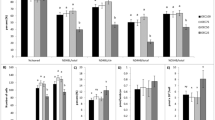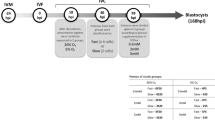Abstract
Purpose: The purpose of this study was to investigate the effect of male and female serum supplementation on the in vitro development of mouse embryos beyond the blastocyst stage until the outgrowth stage since the latter may be related to the nidation of the embryo. We also studied the effect of EGF addition on embryo culture and blastocyst outgrowth.
Methods and Results: The blastocyst and hatching rates of two-cell mouse embryos cultured in Ham's F-10+BSA, Ham's F-10+male serum, or Ham's F-10+female serum were found to be comparable (P>0.05). The outgrowth rate of hatched blastocysts was significantly increased, though, when they were transferred to 50% male serum compared to either 50% BSA or 50% female serum (P<0.01 and P<0.05, respectively). In the last experiment, either 100 or 150 ng/ml EGF was added to the culture medium from the two-cell stage till blastocyst development and the latter were cultured till outgrowth in 50% BSA, male serum, or female serum. For both concentrations of EGF, the outgrowth rate was significantly higher in male serum compared to the other conditions (P<0.01 and P<0.05, respectively). The outgrowth rate was also higher when EGF was used compared to plain medium before transferring the blastocysts to either male or female serum (P<0.01 for both).
Conclusions: We conclude that the development of embryos to the outgrowth stage is significantly enhanced by male serum. The addition of EGF from the two-cell stage also significantly improves the outgrowth success rate for both male and female serum conditions.
Similar content being viewed by others
References
Juurlink BHJ, Fedoroff S: Effects of culture milieus on the development of mouse blastocysts in vitro. Fertil Steril 1977;13:790–798
Saito H, Berger T, Mishell DR Jr, Marrs RP: The effect of serum fractions on embryo growth. Fertil Steril 198;444:761–765
Leung PCS, Gronow MJ, Kellow GN, Lopata A, Speris AL, Mc Boun JC, du Plessis YP, Johnston I: Serum supplementation in human in vitro fertilization and embryo development. Fertil Steril 1984;41:36–39
Ball GD, Coulam GB, Field CS, Harms RW, Thie JT, Byers AP: Effect of serum source on human fertilization and embryonic growth parameters in vitro. Fertil Steril 1985;44:75–79
Pool TB, Martin JE: High continuing pregnancy rates after in vitro fertilization-embryo transfer using medium supplemented with a plasma protein fraction containing α- and β-globulins. Fertil Steril 1994;61:714–719
Ogawa T, Tsutomu O, Marrs RP: The effect of serum fractions on single-cell mouse embryos in vitro. J Vitro Fert Embryo Transfer 1987;4:153–159
Benadiva CA, Kuczynski-Brown B, Maguire TG, Mastroianni L Jr, Flickinger GL: Bovine serum albumin (BSA) can replace patient serum as a protein source in an vitro fertilization (IVF) program. J Vitro Fert Embryo Transfer 1989;6:164–167
Han H-D, Kiessling AA: In vivo development of transferred mouse embryos conceived in vitro in simple and complex media. Fertil Steril 1988;50:159–163
Caro CM, Trounson A: Successful fertilization, embryo development and pregnancy in human in vitro fertilization (IVF) using a chemically defined culture medium containing no protein. J Vitro Fert Embryo Transfer 1986;3:215–217
Loutradis D, Kallianidis K, Drakakis P, Michalas S, Milingos S, Bletsa R, Aravantinos L, Creatsas G, Kiessling AA: Successful pregnancy in human IVF using BSA as a protein source in the transfer medium. ARTA 1992;3:233–238
Jackson KV, Kiessling AA: Fertilization and cleavage of mouse oocytes exposed to the conditions of human oocyte retrieval for in vitro fertilization. Fertil Steril 1989;51:675–681
Fleetham JA, Pattinson HA, Mortimer D: The mouse embryo culture system: improving the sensitivity for use as a quality control assay for human in vitro fertilization. Fertil Steril 1993;59:192–196
Gwatkin RBL: Amino acid requirements for attachment and outgrowth of mouse blastocyst in vitro. Cell Physiol 1966;68:335–344
Hsu Y-C: Post-blastocyst differentiation in vitro. Nature 1971;231:100–102
Spindle AI, Pedersen RA: Hatching, attachment and outgrowth of mouse blastocysts in vitro: Fixed nitrogen requirements. J Exp Zool 1980;186:305–318
Armant DR, Kaplan HA, Lennarz WJ: Fibronectin and laminin promote in vitro Attachment and outgrowth of mouse blastocysts. Dev Biol 1986;116:519–523
Buyalos RP, Cai X: Preimplantation embryo development enhanced by epidermal growth factor. J Assist Reprod Genet 1994;11:33–37
Adashi EY, Resnick CE, Hurwitz A, Ricciarelli E, Hernandez ER, Roberts CT, Leroith D, Rosenfeld R: Insulin-like growth factors: The ovarian connection. Hum Reprod 1991;6:1213–1219
Hsu C-J, Hammond JM: Concomitant effects of growth hormone on secretion of insulin-like growth factor I and progesterone by cultured porcine granulosa cells. Endocrinology 1987;121:1343–1348
Dekel N, Sherizly I: Epidermal growth factor induces maturation of rat follicle-enclosed oocytes. Endocrinology 1985;116:406–412
Das K, Phipps WR, Hensleigh HC, Tagatz GE: Epidermal growth factor in human follicular fluid stimulates mouse oocyte maturation in vitro. Fertil Steril 1992;57:895–901
Morishige KI, Kurachi H, Amemiya K, Adashi H, Adashi K, Sakoyama Y, Miyake A, Tanizawa O: Menstrual stage-specific expression of epidermal growth factor and transforming growth factor-alpha in human oviduct epithelium and their role in early embryogenesis. Endocrinology 1993;133:199–207
Kurachi H, Morishige K, Imai T, Homma H, Masumoto N, Yoshimoto Y, Miyake A: Expression of epidermal growth factor and transforming growth factor-alpha in fallopian tube epithelium and their role in embryogenesis. Hormone Res 1994;41 (Suppl 1):48–54
Giudice LC, Dsupin BA, Irwin JC, Eckert RL: Identification of insulin-like growth factor binding proteins in human oviduct. Fertil Steril 1992;57:294–301
Brice EC, Wu JX, Muraro R, Adamson ED, Wiley LM: Modulation of mouse preimplantation development by epidermal growth factor receptor antibodies, antisense RNA, and deoxyoligonucleotides. Dev Genet 1993;14:174–184
Goldman S, Dirnfeld M, Koifman M, Gonen Y, Lissak A, Abramovici H: The effect of epidermal growth factor on growth and differentiation of mouse preimplantation embryos in vitro. Hum Reprod 1993;8:1459–1462
Morita Y, Tsutsumi O, Taketani Y: In vitro treatment of embryos with epidermal growth factor improves viability and increases the implantation rate of blastocysts transferred to recipient mice. Am J Obstet Gynecol 1994;171:406–409
Corps AN, Brigstock DR, Littlewood CJ, Brown KD: Receptors for epidermal growth factor and insulin-like growth factor-I on preimplantation trophoderm of the pig. Development 1990;110:221–227
Harper KM, Brackett BG: Bovine blastocyst development after in vitro maturation in a defined medium with epidermal growth factor and low concentrations of gonadotropins. Biol Reprod 1993;48:409–416
Brown MJ, Zogg JL, Schultz GS, Hilton FK: Increased binding of epidermal growth factor at preimplantation sites in mouse uteri. Endocrinology 1989;124:2882–2888
Paria BC, Das SK, Andrews GK, Dey SK: Expression of the epidermal growth factor receptor gene is regulated in mouse blastocysts during delayed implantation. Endocrinology 1994;134:971–981
Das SK, Tsukamura H, Paria BC, Andrews GK, Dey SK: Differential expression of epidermal growth factor receptor (EGF-R) gene and regulation of EGF-R bioactivity by progesterone and estrogen in the adult mouse uterus. Endocrinology 1994;134:971–981
Das SK, Wang X-N, Paria BC, Damm D, Abraham JA, Klagsbrun M, Andrews GK, Dey SK: Heparin-binding EGF-like growth factor gene is induced in the mouse uterus temporally by the blastocyst solely at the site of its apposition: A possible ligand for interaction with blastocyst EGF-receptor in implantation. Development 1994;120:1071–1083
Ham RG: An improved nutrient solution for diploid chinese and human cell lines. Exp Cell Res 1963;29:516–526
Loutradis D, John D, Kiessling AA: Hypoxanthine causes a 2-cell block in random bred mouse embryo. Biol Reprod 1987;37:311–316
Nureddin A, Epsaro E, Kiessling AA: Purines inhibit the development of mouse embryos in vitro. J Reprod Fertil 1990;90:455–464
Shirley B, Wortham JWE Jr, Witmyer J, Condon-Mahony M, Fort G: Effects of human serum and plasma on development of mouse embryos in culture media. Fertil Steril 1985;43:129–134
Defire LHK, De Laat SW: Structural and functional aspects of epidermal growth factor (EGF) and its receptor.In Progress in Brain Research, WH Gispen, A Routtenberg (eds). Amsterdam, Elsevier, 1986, Vol 69, pp 165–182
Galway AB, O' Kawa M, Ny T, Hsueh AJW: Epidermal growth factor stimulates tissue plasminogen activator activity and messenger ribonucleic acid levels in cultured rat granulosa cells: Mediation by pathways independent of protein kinases-A and -C. Endocrinology 1989;120:126–135
Reuse S, Roger PR, Vassart G, Dumont JE: Enhancement of c-myc mRNA concentration in dog thyrocytes initiating DNA synthesis in response to thyrotropin, forskolin, epidermal growth factor and phorbol myristate ester. Biochem Biophys Res Commun 1986;141:1066–1077
Nielsen LL, Werb, Z, Pedersen RA: Induction of c-fos transcripts in early post-implantation mouse embryos by TGF-α, EGF, PDGF and FGF. Mol Reprod Devel 1991;29:227–237
Kiessling AA, Davis HW, Williams CS, Sauter RW, Harrison LW: Development and DNA polymerase activity in cultured preimplantation mouse embryos: Comparison with embryos developed in vivo. J Exp Zool 1991;258:34–47
Bowman P, Mc Laren A: Cleavage rate of mouse embryos in vivo and in vitro. J Embryol Exp Morphol 1970;24:203–207
Author information
Authors and Affiliations
Rights and permissions
About this article
Cite this article
Drakakis, P., Loutradis, D., Milingos, S. et al. The in vitro development of mouse embryos beyond the blastocyst stage into the hatching and outgrowth stage using different energy sources. J Assist Reprod Genet 13, 786–792 (1996). https://doi.org/10.1007/BF02066499
Received:
Accepted:
Issue Date:
DOI: https://doi.org/10.1007/BF02066499




